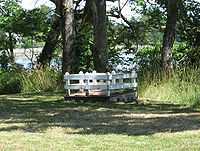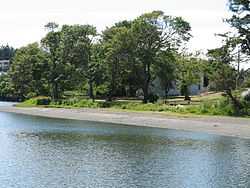Craigflower Manor and Schoolhouse
| Craigflower Manor and Schoolhouse | |
|---|---|
|
Craigflower Farm from a distance. | |
| Type | Manor; schoolhouse; agricultural community |
| Etymology | The Craigflower Farm in England |
| Location | Vancouver Island, Victoria, British Columbia, Canada |
| Founded | 1853 |
| Founder | Puget Sound Agricultural Company |
| Built | 1853–1856 |
| Architectural style(s) | Georgian Revival |
| Governing body | Parks Canada |
| Website | Craigflower Manor |
| Designated | 1975 |
The Craigflower Manor and Craigflower Schoolhouse are National Historic Sites of Canada located in View Royal, British Columbia (the Manor) and Saanich (the Schoolhouse) near Victoria. The centerpiece of each historic site is a 19th-century building — a manor and schoolhouse commissioned by the Hudson's Bay Company to provide education and lodging for their employees. Built as part of the agricultural community Craigflower Farm, the buildings served as a focal point for the community into the modern era;[1][2] they remain open to the public today as museums devoted to the colonial history of Victoria.[3][4]
The sites also have unique archaeological merit, encompassing three distinct periods, and types, of human habitation which span thousands of years.[5] In addition, the existing structures have great historical and cultural value, remaining some of the best, and last, examples of their kind in Canada. These factors combine to make these two sites important National Historic Sites, and have been given government protection for the public trust.[6][7]
Site history

The land in the area was formed during the last ice age in North America, approximately 13,000 years ago, when receding glaciers carved a deep gouge into the earth, which became a number of small lakes and streams. Over time, these lakes rejoined the ocean, becoming a salt-water inlet known today as the Gorge waterway, which the indigenous people call "Kosapsom".[5] The Lekwungen, a Coast Salish tribe and ancestors of the modern Esquimalt and Songhees First Nations, settled in the area, calling the whole region "Camossung", after the legend of a girl they believed was turned to stone there.[8]
Archaeologists working in the Gulf of Georgia, Vancouver Island, and the Lower Mainland have identified several distinct periods of cultural activity, known as "culture types" in the region. The site at Craigflower Farm exhibits three of these culture types, known as "Locarno Beach", "Gulf of Georgia" and "Historic".[5] The "Historic" culture type refers to the colonial settlement of the area, and is contiguous with the European colonization; a majority of the artifacts recovered from the site have been dated to this period.[9]
The other two periods of human habitation are discernible mainly by the presence of a large shell midden on the site; testifying to the abundant shellfish and game in the area. The earliest of the periods, the "Locarno Beach" type, used many different types of stone tools, including microblades, adzes, and other shaped or sharpened objects.[5] The next culture type, dating from around 2500 years ago and known as the "Gulf of Georgia" type, is characterized by an increased use of bone tools, such as wedges and awls made from antlers, as well as different kinds of wood. This culture type's presence on the site ends with the arrival of Europeans, and the colonization of Vancouver Island[5] — altogether, around 1000 indigenous artifacts were recovered from the site during two separate archaeological digs.[9]
Both the manor and the schoolhouse were part of a settlement known as Craigflower Farm, which was one of Western Canada's first farming communities. Established in 1853 by the Puget Sound Agricultural Company, a subsidiary of the Hudson's Bay Company, the farm was to supply fresh produce to the nearby Fort Victoria, and to aid in settlement of lower Vancouver Island.[1] The farm was named after Craigflower Farm in England which was owned by Andrew Colville, Governor of the Hudson's Bay Company from 1852 to 1856.[10]:47 The land for the farm, was purchased from the Esquimalt First Nation (recorded as the "Kosapsom" on the treaty) in 1850, who relocated nearby.[5][6][11]
Craigflower Schoolhouse

Originally called Maple Point School, the schoolhouse was commissioned by first farm director, Kenneth McKenzie, to provide education for the children of farm employees. This was to be the third school constructed in the colony of Vancouver Island, following Governor James Douglas' call "to give a proper moral and religious training to the children of the settlers who are growing up in ignorance and the utter neglect of all their duties to God and society."[2] The need was judged to be most severe for children of Protestant denomination, as Roman Catholics received (until 1851) "very able and zealous" instruction from a priest from the Society des Oblats.[2] Construction was commenced, using timber milled on the farm, in August 1854 and continued until late February 1855.[12] The first students took classes there in March of the same year, and were charged a fee of between 30 shillings and 1 pound.[2][13]
The two-story building was built in Georgian Revival style, and boasted a single schoolroom on the first floor, as well as six rooms for the teacher, their family, and student boarders from other parts of Vancouver Island. A large brick fireplace, as well as a stove, provided heating for the building, and a bell salvaged from the wrecked steamship Major Tompkins was hung in the yard to call students to class. Initially, the school was accessible from the main part of the farm only by boat, but the 1856 completion of the first Craigflower bridge linked the two parts of the farm together.[13]
The schoolhouse became the focal point of social and religious events on the farm, and saw continuous use until 1872 when town council neglected to provide funding for Victoria's schools. However, Education Act amendments returned the school to operation soon after, and in 1873 education was made mandatory for students aged seven to 14.[2][13] The school continued to operate until 1911, when it was replaced by the second Craigflower school, built across the road. The current school, called Craigflower Elementary School, was built in 1964 to replace the aging 1911 building. The schoolhouse, however, was converted into a museum in 1931 and run by a local service club until 1975 when the provincial Historical Parks board acquired it and restored the structure.[13] It is still open today as a museum, located at 2755 Admirals Road, and managed by The Land Conservancy of British Columbia in public trust[3] — it is the oldest surviving schoolhouse in Western Canada, though it is often erroneously referred to as "the first school built in British Columbia".[2][12]
Craigflower Manor

The manor house was built shortly after the completion of the schoolhouse, to serve as a home and office for the management of the Craigflower farm, and their family. The house was constructed as a Georgian Revival version of a Scottish manor house, at the request of Kenneth McKenzie's wife, Agnes.[14] The foundation was laid in 1853, prior to the McKenzies' arrival, and was completed in May 1856.[4]
A grand, two-story structure, the manor was over 900 square feet (84 m2) in size and second only to the first Government House in elegance.[14] The building boasted a dining room, sitting room, office, music room, kitchen, and four bedrooms for the large McKenzie family. Heat was provided by several fireplaces, serviced by two large brick chimneys.[15] The manor was used as lodging up until 1922, when the Hudson's Bay Company converted it into a community centre. It eventually became a hotel, before being sold to the government in 1965.[15] As the building is the earliest, and one of the few remaining, examples of its type in Western Canada, it was extensively restored in 1967 by the province, before being run as a museum.[7] It is currently open as part of the Craigflower Schoolhouse museum, run by The Land Conservancy, which also grows a community garden on the property.[4]
See also
- Coast Salish peoples
- Colony of Vancouver Island
- United Colonies of Vancouver Island and British Columbia
References
| Wikimedia Commons has media related to Craigflower Manor and Schoolhouse. |
- ↑ 1.0 1.1 "Craigflower Manor and Schoolhouse: An Original Hudson's Bay Company Farm". Government of British Columbia. 2007-06-19. Retrieved 2007-07-06.
- ↑ 2.0 2.1 2.2 2.3 2.4 2.5 "Early schools predated B.C.’s birth". Times Colonist. 2008-01-02. pp. E11. Retrieved 2008-01-09.
- ↑ 3.0 3.1 Wright, Janet. "Craigflower Manor and Schoolhouse". The Canadian Encyclopedia. Retrieved 2007-07-06.
- ↑ 4.0 4.1 4.2 "Craigflower National Historic Site". The Land Conservancy. 2005. Retrieved 2007-07-06.
- ↑ 5.0 5.1 5.2 5.3 5.4 5.5 "History of Kosapsom". Heritage BC. 1999. Retrieved 2007-07-07.
- ↑ 6.0 6.1 "Canada's Historic Places: Craigflower Schoolhouse". Canadian Register of Historic Places. 2007-04-20. Retrieved 2007-07-06.
- ↑ 7.0 7.1 "Canada's Historic Places: Craigflower Manor". Canadian Register of Historic Places. 2007-04-20. Retrieved 2007-07-06.
- ↑ Bryce, Cheryl; Brenda Sam. "Coast Salish Collections: Archeology and Ethnology of the Gulf of Georgia". Heritage BC. Retrieved 2007-07-12.
- ↑ 9.0 9.1 "University of Victoria Report on the Kosapsom Archaeological Dig, 1995". Heritage BC. 1999. Retrieved 2007-07-12.
- ↑ Akrigg, G.P.V.; Akrigg, Helen B. (1969). "1001 British Columbia Place Names" (3rd, 1973 ed.). Vancouver: Discovery Press.
- ↑ "Te'Mexw: Modern Day Treaty Process". Songhees First Nation. Retrieved 2008-03-18.
- ↑ 12.0 12.1 "Craigflower School House National Historic Site of Canada". Parks Canada. 2007-03-15. Retrieved 2007-07-06.
- ↑ 13.0 13.1 13.2 13.3 "Significant Heritage Structures". District of Saanich. Archived from the original on June 28, 2007. Retrieved 2007-07-06.
- ↑ 14.0 14.1 Duffus, Maureen. "Agnes McKenzie’s Craigflower Dream House". Retrieved 2007-07-06.
- ↑ 15.0 15.1 "Teaching, Learning and Farming at Craigflower Farm". Heritage BC. 2000. Retrieved 2007-07-06.
External links
Coordinates: 48°27′10″N 123°25′18″W / 48.452649°N 123.421617°W
| ||||||||||||||||||
